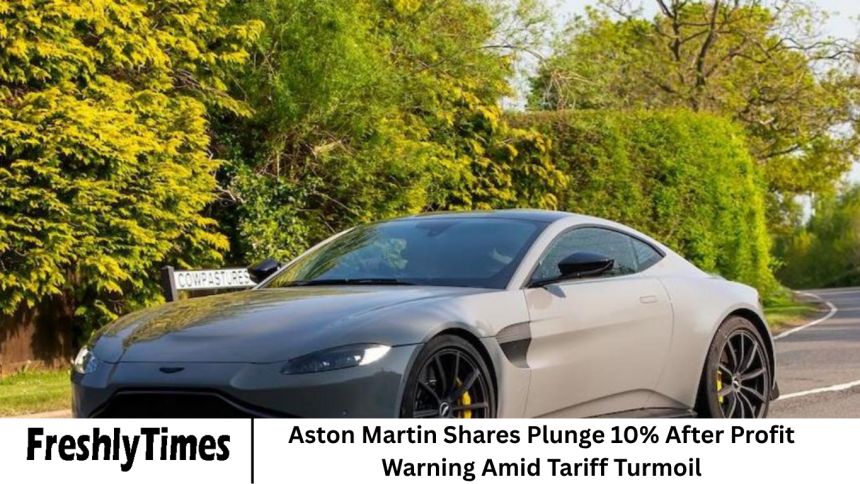Aston Martin Lagonda, the iconic British luxury carmaker known for its association with James Bond and timeless automotive design, has found itself facing a steep decline in investor confidence. The company’s shares plunged 10% after issuing a fresh profit warning, citing the disruptive effects of global tariff.
- The Immediate Trigger: Profit Warning Shakes Investor Confidence
- Tariff Turmoil: The Broader Economic Backdrop
- A Long History of Financial Volatility
- Weak Demand in Key Markets
- The Electric Transition: Opportunities and Hurdles
- Investor and Market Reactions
- The Broader Luxury Auto Landscape
- Potential Recovery Pathways
- Leadership Response
- Frequently Asked Question
- Conclusion
This latest announcement adds to a growing list of challenges facing the storied automaker, which has been struggling to balance its brand prestige with financial stability. The profit warning reflects not only short-term trade disruptions but also long-standing structural problems.
In this in-depth analysis, we’ll explore the reasons behind Aston Martin’s stock tumble, the broader context of tariff turmoil, and what lies ahead for one of the world’s most recognizable car brands.
More Read: BBVA Has €8 Billion Ready for Sabadell Bid, Says CEO
The Immediate Trigger: Profit Warning Shakes Investor Confidence
Aston Martin’s management issued a statement warning that full-year profits would fall below expectations, primarily due to weaker demand in China and Europe and cost pressures linked to new import tariffs between major economies.
Investors reacted swiftly. Shares fell by 10% in early London trading, wiping hundreds of millions of pounds off the company’s market value. Analysts described the announcement as a “blow to the brand’s recovery narrative” after previous reassurances from CEO Amedeo Felisa.
Key Financial Highlights:
- Share drop: 10% intraday decline
- Full-year earnings: Expected to fall short of guidance
- Primary causes: Tariff disruptions, cost inflation, and softer demand
- Debt levels: Remain high, with net debt exceeding £700 million
The profit warning has cast doubt on Aston Martin’s turnaround plan, which had been gaining modest traction following its partnerships with Mercedes-Benz and investments in hybrid technology.
Tariff Turmoil: The Broader Economic Backdrop
The luxury automaker’s warning didn’t occur in isolation. Across the automotive industry, companies are facing renewed uncertainty as tariff disputes between global powers disrupt the flow of components and finished vehicles.
Recent tensions between the European Union, the United States, and China have reignited fears of a trade war that could increase the cost of exporting high-end cars. For a niche player like Aston Martin — whose models are handcrafted and rely on specialized parts sourced globally — tariffs can have a disproportionate impact.
How Tariffs Are Hurting Aston Martin
- Supply Chain Costs: Import duties on key components such as engines, electronics, and aluminum frames have raised production costs.
- Market Access: Tariffs make Aston Martin’s already expensive cars even pricier in key markets like China, dampening demand.
- Investment Uncertainty: Constant trade policy shifts discourage long-term planning, especially for capital-intensive products like electric vehicles.
Economists have warned that small-scale luxury automakers are more exposed to tariffs than mass-market producers because they cannot easily shift production or absorb cost increases without hurting profitability.
A Long History of Financial Volatility
Aston Martin’s financial troubles are not new. Despite its fame, the company has faced seven bankruptcies over its century-long history. Its challenges stem from a delicate balance: maintaining exclusivity while achieving enough scale to remain profitable.
In 2018, Aston Martin went public on the London Stock Exchange, initially valued at over £4 billion. However, following a series of missed production targets, weak sales, and the pandemic’s impact on luxury spending, its market capitalization has since plunged dramatically.
The company has repeatedly sought new capital injections, including:
- Lawrence Stroll’s investment consortium in 2020, which brought Formula 1 marketing synergies.
- A partnership with Mercedes-Benz, giving Aston Martin access to advanced technology in exchange for equity.
- Multiple rights issues to raise cash for electrification and new model development.
Despite these efforts, profitability remains elusive. Analysts say the firm’s debt burden and its limited scale make it difficult to compete with better-capitalized rivals like Ferrari and Bentley.
Weak Demand in Key Markets
While tariffs play a major role, consumer behavior also weighs heavily on Aston Martin’s outlook. Demand for ultra-luxury sports cars has slowed in major markets, particularly China, where a sluggish economy and stricter import regulations have reduced appetite for foreign luxury goods.
In Europe, high inflation and rising interest rates have further squeezed discretionary spending, making big-ticket luxury purchases less attractive.
Meanwhile, in the United States, which remains Aston Martin’s single largest market, competition from electric rivals such as Tesla’s Roadster and Porsche’s Taycan is drawing away potential buyers.
The China Challenge
Aston Martin’s expansion strategy in Asia has struggled to gain traction. Unlike Ferrari and Lamborghini, the brand lacks strong recognition among younger luxury buyers in China.
Tariffs on UK-made cars have made prices even steeper, pushing customers toward domestic luxury EV startups offering cutting-edge technology and tax incentives.
The Electric Transition: Opportunities and Hurdles
Aston Martin’s future hinges on how well it adapts to the electrification revolution sweeping the auto industry. The company has announced plans to launch its first fully electric vehicle in 2026, supported by Mercedes-Benz technology.
However, this transformation is capital-intensive, and Aston Martin faces the difficult task of funding new EV development while servicing its existing debt. The brand’s upcoming Valhalla hybrid supercar, expected in 2025, is intended to bridge the gap between its traditional V12-powered models and its future electric lineup.
But analysts warn that the company cannot afford further delays or cost overruns.
Strategic Priorities for the Next Phase
- Accelerate electrification with the help of Mercedes-Benz.
- Streamline production to cut costs and improve margins.
- Strengthen the brand’s digital and customer engagement strategy.
Expand presence in emerging luxury markets beyond China, such as the Middle East and India.
The company’s leadership maintains that the brand’s legacy and technological partnerships position it well for a sustainable turnaround — but investors remain skeptical after repeated disappointments.
Investor and Market Reactions
The financial community reacted sharply to Aston Martin’s latest announcement. Several major brokerage firms downgraded their ratings, citing uncertainty about the company’s path to profitability.
Analyst Comments:
- Morgan Stanley: “Aston Martin faces structural headwinds. Tariffs may be temporary, but weak demand and high leverage are long-term concerns.”
- Barclays: “Execution risk remains high. Investors will want to see concrete progress on electrification and cost control before confidence returns.”
- Jefferies: “The share price drop reflects eroding trust. Investors have heard similar reassurances before.”
Institutional investors, particularly those who participated in previous rights issues, are reportedly frustrated by the recurring setbacks. The sharp decline in share price could also complicate Aston Martin’s efforts to raise further capital if needed.
The Broader Luxury Auto Landscape
Aston Martin’s struggles highlight the diverging fortunes within the luxury car segment. While brands like Ferrari, Lamborghini, and Rolls-Royce have reported record profits and order backlogs, smaller or less diversified luxury automakers have been hit harder by market volatility and trade tensions.
Ferrari, for instance, benefits from unmatched brand strength and disciplined supply control, maintaining high margins even in turbulent times. In contrast, Aston Martin’s attempt to expand production volumes has often backfired, diluting exclusivity without delivering financial stability.
Meanwhile, the shift toward electric luxury vehicles has reshuffled the competitive landscape. Startups like Lucid Motors and Rimac are redefining performance benchmarks with cutting-edge EV technology, while established brands like Bentley and Porsche are investing heavily in sustainability and software-driven design.
Aston Martin’s slower transition risks leaving it behind in an industry that’s rapidly being reshaped by innovation and green policies.
Potential Recovery Pathways
Despite the bleak outlook, Aston Martin still holds valuable assets: a globally recognized brand, a loyal base of enthusiasts, and partnerships that could anchor its next phase of transformation.
Industry analysts suggest several recovery strategies:
- Leveraging Formula 1 Exposure: The Aston Martin Aramco Formula 1 team provides global visibility that could strengthen brand perception among younger, tech-savvy audiences.
- Expanding Customization Options: Enhancing bespoke programs could increase profit margins per vehicle and reinforce exclusivity.
- Tapping New Luxury Niches: The rise of ultra-luxury SUVs, like the DBX707, has shown strong demand in select markets. Expanding this segment could offset declining sports car sales.
- Debt Restructuring: Further refinancing could give the company breathing room to fund new technologies.
- Selective Market Diversification: Expanding in regions less affected by tariffs — such as the Middle East — could stabilize sales.
While each path carries risks, success will depend on disciplined execution and the ability to deliver consistent profitability — something that has eluded Aston Martin for decades.
Leadership Response
In a statement following the profit warning, CEO Amedeo Felisa emphasized the company’s long-term vision:
“Aston Martin remains committed to delivering exceptional products and experiences. Short-term market disruptions will not derail our strategy to become the world’s most desirable ultra-luxury British performance brand.”
He also reaffirmed the company’s goal of achieving positive free cash flow by 2026, citing progress in operational efficiency and new product launches. However, investors are demanding faster, more tangible results before restoring confidence.
Frequently Asked Question
Why did Aston Martin’s shares fall 10%?
The decline followed a profit warning indicating that full-year earnings would miss expectations due to global tariff disruptions, rising costs, and weakening demand in key markets like China and Europe.
What are the main reasons behind Aston Martin’s financial struggles?
Aston Martin has long faced challenges such as high debt, inconsistent production volumes, and intense competition. Recent issues like tariffs and slowing global demand have exacerbated these structural problems.
How are tariffs affecting Aston Martin?
Tariffs on imported components and finished cars have increased production costs and made its vehicles more expensive in key export markets. This has dampened sales and squeezed profit margins.
What is Aston Martin doing to recover?
The company is focusing on cost control, electrification, expanding its SUV lineup, and leveraging its Formula 1 visibility. It also aims to achieve positive free cash flow by 2026.
How does Aston Martin compare to rivals like Ferrari and Bentley?
Unlike Ferrari and Bentley, Aston Martin lacks consistent profitability and scale. Its brand remains strong, but financial instability and slower electrification progress put it at a disadvantage.
Will electrification help Aston Martin’s future?
Yes, but only if executed effectively. The company plans to launch its first electric vehicle in 2026, supported by Mercedes-Benz technology. Successful electrification could be key to long-term survival.
Is Aston Martin at risk of bankruptcy again?
While bankruptcy isn’t imminent, the company remains vulnerable. High debt, negative cash flow, and volatile demand could lead to further financial distress if market conditions don’t improve soon.
Conclusion
Aston Martin’s 10% share drop reflects not only a reaction to immediate market turbulence but also deeper anxieties about the brand’s long-term sustainability. The combination of tariff headwinds, softening demand, and mounting debt threatens to derail its fragile recovery.
The automaker’s future will hinge on its ability to adapt to global trade realities, accelerate electrification, and leverage its heritage without being constrained by it. In a world where luxury consumers increasingly value innovation and sustainability, Aston Martin must evolve or risk becoming a relic of its own glorious past.














